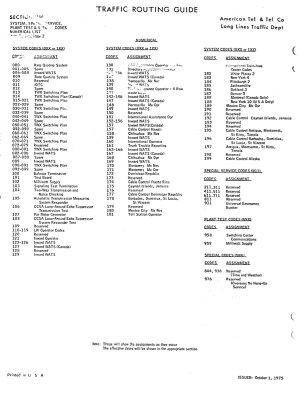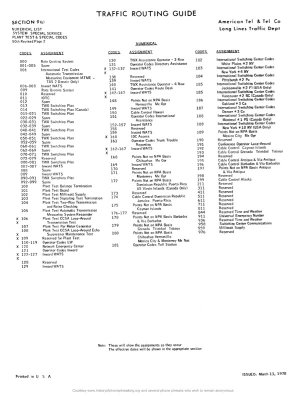EXPLODING THE PHONE
The Untold Story of the Teenagers and Outlaws Who Hacked Ma Bell
Extra Goodies
Below are goodies that could not be included in the book due to space constraints. Enjoy.
Extra Goodies — 0xx/1xx Codes
If you spent any time thinking about U.S. telephone numbers back in the day, you quickly realized that they didn't start with 000 through 199. And that's because numbers starting with these codes were internal telephone company numbers. Some were routing codes ("terminating toll center" or TTC codes) for reaching particular cities within an area code, others went to special operators, others connected you to special purpose computers, and still others were for equipment testing.
The best known were 121 (inward operator), 131 (directory assistance operator), and 141 (rate-and-route operator) but there were many others.
Of course, customers weren't supposed to be able to dial these codes, only operators, or technicians on the test board. But, occasionally a telephone switch might be misconfigured. Indeed, in Chapter 6, "Some People Collect Stamps," Charlie Pyne discovers that the entire 331 exchange in Boston simply sends out whatever four digits he dialed after the 331 into a tandem. By dialing 331-1212, he could connect to the inward operator: the switching equipment just sent "1212" into his local tandem, and the tandem recognized the first three digits (121) and connected him to the inward operator. Similarly, in Chapter 1, "Fine Arts 13," Jake Locke discovers that by dialing a number ending in "1212" in British Columbia he, too, gets connected to an inward operator.
If you had a blue box, of course, you could dial these codes at will. Phone phreaks spent a lot of time scanning for interesting 0xx/1xx codes -- that is, exhaustively trying all 200 codes in a given tandem -- to discover what they did.
The phone company had a list, of course. Below are two pages from the 1975 and 1977 Traffic Routing Guide, describing the "Special Service Codes" that could be dialed.
 |
 |
1975 | 1977 |
Click on the images for pdfs.
Sources and Notes
The pages above are taken from the Traffic Routing Guide, 1975 and 1977 editions, published by AT&T.
An HTML version, apparently based on the above documents, can be found here. Another document, from 1985, provides a bit more explanation of many of the codes.